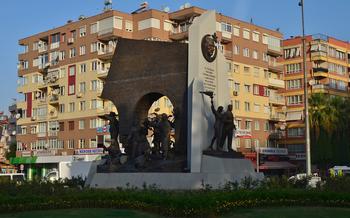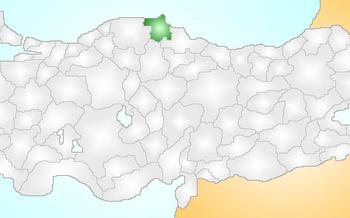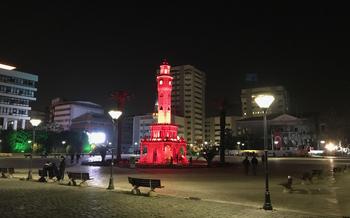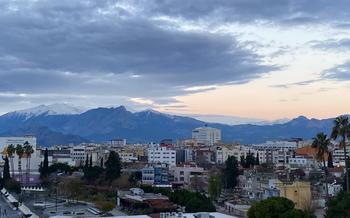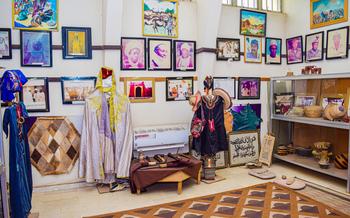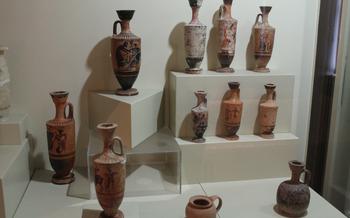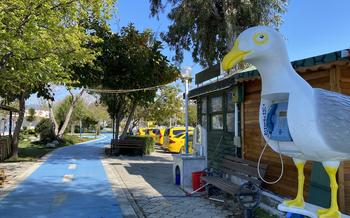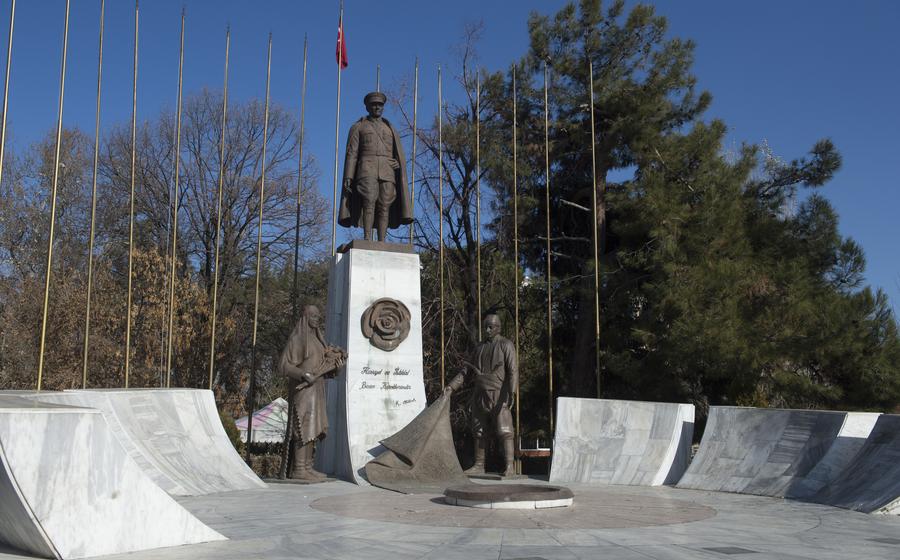
Prostanna Ancient City
- The Antiquity of Isparta: A Historical Legacy
- Prostanna: A City Lost in Time
- Exploring Prostanna's Ruins: A Journey into the Past
- The Temple of Apollo: A Majestic Symbol of Worship
- The Theater of Prostanna: A Stage for Ancient Performances
- The Agora: The Heart of Prostanna's Civic Life
- The Necropolis: A City of the Dead
- The Archaeological Museum of Isparta: A Treasure Trove of Discoveries
- Festivals and Events in Isparta: Celebrating the Past and Present
- Local Cuisine: A Culinary Journey Through History
- Getting to Prostanna: A Journey Through Scenic Landscapes
- Practical Information for Visitors: Planning Your Trip
- Guided Tours: Unlocking the Secrets of Prostanna
- Photography Tips: Capturing the Beauty of Prostanna
- Insider Tip: Discovering Hidden Gems
The Antiquity of Isparta: A Historical Legacy
Isparta, a city in southwestern Turkey, boasts a rich and storied past that dates back to ancient times. The region has long been a crossroads of civilizations, with various empires and cultures leaving their mark on the city's development. Archaeological discoveries in and around Isparta have shed light on its fascinating history, revealing the influence of Greek, Roman, Byzantine, and Ottoman rule. The city's unique blend of architectural styles, cultural traditions, and historical landmarks make it a compelling destination for travelers seeking to delve into the depths of Turkey's ancient heritage.
Prostanna: A City Lost in Time
In the heart of Isparta's ancient legacy lies the enigmatic city of Prostanna, a testament to the region's rich cultural tapestry. Strategically situated at the crossroads of ancient civilizations, Prostanna's history is shrouded in mystery, its origins lost to the sands of time. Once a thriving metropolis, Prostanna served as a cultural and religious center, its influence radiating throughout the region.
Excavations have brought to light the city's remarkable history, revealing a sophisticated urban center that rivaled its contemporaries. Temples, theaters, and public buildings stand as silent witnesses to Prostanna's grandeur, while intricate mosaics and frescoes offer glimpses into its vibrant artistic heritage. As archaeologists continue to unearth the secrets of this lost city, Prostanna emerges as a fascinating destination for history buffs and travelers seeking a journey into the past.
Exploring Prostanna's Ruins: A Journey into the Past
Venture through the ancient city of Prostanna and marvel at its well-preserved ruins that transport you back in time. Explore the impressive architectural remains, including temples, theaters, and public buildings that stand as testaments to the city's former glory. Admire the intricate network of streets and alleyways that provide a glimpse into the city's layout and imagine the daily lives of its inhabitants. Immerse yourself in the evocative atmosphere that permeates the ruins, allowing you to experience the grandeur and history that once defined Prostanna.
The Temple of Apollo: A Majestic Symbol of Worship
The Temple of Apollo, situated in the heart of Prostanna, stands as a testament to the city's deep-rooted religious beliefs and practices. Dedicated to the revered Greek god of music, poetry, and prophecy, this imposing structure played a pivotal role in the spiritual lives of the ancient inhabitants.
Constructed in the 2nd century AD, the temple's grand scale and intricate architectural features reflect the significance it held in Prostanna's religious landscape. Its towering columns, finely carved pediments, and exquisite friezes showcase the city's artistic prowess and devotion to Apollo.
Within the temple's sacred chambers, priests performed elaborate rituals and ceremonies to honor Apollo and seek divine guidance. Devotees from far and wide flocked to Prostanna to participate in these religious observances, seeking blessings, healing, and inspiration from the revered deity.
Archaeological excavations at the temple have unearthed a wealth of artifacts that provide insights into its history and function. Statues, inscriptions, and votive offerings dedicated to Apollo shed light on the religious beliefs and practices of Prostanna's inhabitants.
Today, visitors to the Temple of Apollo can marvel at its enduring grandeur and imagine the sacred atmosphere that once permeated its walls. This awe-inspiring monument stands as a reminder of Prostanna's rich religious heritage and the enduring legacy of ancient Greek worship.
The Theater of Prostanna: A Stage for Ancient Performances
The Theater of Prostanna stands as a testament to the city's rich cultural heritage. Built in the classical Greek style, this impressive structure boasts remarkable acoustics and stage mechanisms that facilitated a variety of theatrical productions. The theater's vast seating capacity and carefully designed stage allowed for grand performances that captivated audiences in ancient times.
Imagine the atmosphere as actors graced the stage, their voices resonating throughout the theater, carrying tales of gods, heroes, and human struggles. The theater hosted not only plays but also concerts and religious ceremonies, creating a vibrant space for artistic expression and community gatherings.
Attending a performance in the ancient theater is an experience that transports visitors back in time. The immersive atmosphere, combined with the echoes of history, creates a truly unforgettable moment. As you sit among the ancient stone seats, let your imagination soar, and envision the spectacle that once unfolded on this very stage.
The Agora: The Heart of Prostanna's Civic Life
The agora, the bustling heart of Prostanna, served as a vibrant marketplace, civic center, and social gathering place. This central square was the stage for the city's daily life, where locals converged to conduct business, exchange ideas, and socialize.
The agora's architectural design reflected its multifaceted role. Rows of shops and stalls lined the perimeter, offering a diverse array of goods from fresh produce to handcrafted wares. Colonnades provided shade and shelter, creating a pleasant environment for browsing and haggling. Public buildings, such as administrative offices and meeting halls, stood prominently within the agora, symbolizing the city's civic functions.
Within the agora, a constant hum of activity filled the air. Merchants touted their wares, buyers bartered for the best prices, and citizens engaged in lively conversations. The air was thick with the scent of spices, freshly baked bread, and grilled meats emanating from the surrounding shops.
The agora was not merely a place of commerce; it was also a hub for social interaction and community events. Residents gathered here to exchange news, discuss politics, and celebrate festivals. Religious ceremonies, theatrical performances, and public announcements often took place within the agora, further enhancing its significance as a focal point of civic life.
As the sun began to set, the agora transformed into a social gathering place. Locals strolled through the colonnades, enjoying the cool evening breeze and engaging in lively conversations. The agora's vibrant atmosphere extended into the night, with flickering oil lamps casting a warm glow over the square.
Exploring the agora today, visitors can still sense the bustling energy of this ancient marketplace. The well-preserved ruins, including shop foundations, colonnades, and public buildings, offer a glimpse into the vibrant civic life that once thrived here.
The Necropolis: A City of the Dead
Lying just outside the ancient city walls, the necropolis of Prostanna is a poignant reminder of the city's past inhabitants. This vast cemetery, with its rows of tombs and burial chambers, provides a glimpse into the funerary customs and beliefs of the ancient Prostannians.
The necropolis is divided into several sections, each dedicated to a different social class or ethnic group. The most elaborate tombs belong to the city's elite, featuring intricate carvings, colorful frescoes, and even small altars for offerings to the deceased. In contrast, the tombs of the common people are more modest, often consisting of simple stone markers or underground chambers.
Archaeological excavations have revealed a variety of burial practices in the necropolis. Some bodies were buried in wooden coffins, while others were laid to rest in stone sarcophagi. In some cases, the deceased were cremated, and their ashes were placed in urns or buried in small pits.
The necropolis also contains a number of communal tombs, where multiple individuals were buried together. These tombs often belonged to families or religious groups. The presence of these communal tombs suggests that the ancient Prostannians had a strong sense of community and solidarity, even in death.
Exploring the necropolis of Prostanna is a thought-provoking and moving experience. It is a place where the past and present converge, and where visitors can gain a deeper understanding of the lives and deaths of the people who once called this ancient city home.
The Archaeological Museum of Isparta: A Treasure Trove of Discoveries
The Archaeological Museum of Isparta is a treasure trove of artifacts and discoveries that shed light on the rich history and cultural heritage of the region. Founded in 1976, the museum houses a vast collection of artifacts from Prostanna and other archaeological sites in the Isparta province.
The museum's exhibits are organized chronologically, taking visitors on a journey through the various periods of Isparta's history, from the Neolithic Age to the Ottoman Empire. Among the highlights of the collection are intricate mosaics and frescoes from Prostanna, as well as pottery, jewelry, coins, and sculptures from different eras.
The Archaeological Museum of Isparta is not only a repository of ancient artifacts but also a valuable educational and research center. The museum regularly hosts temporary exhibitions, lectures, and workshops that explore various aspects of Isparta's history and culture.
For visitors interested in delving deeper into the region's past, the museum's library and research facilities provide access to a wealth of resources, including books, journals, and archaeological reports. The museum's staff is also available to assist visitors with their research inquiries and provide guidance on exploring other archaeological sites in the area.
A visit to the Archaeological Museum of Isparta is an essential experience for anyone interested in the history and culture of Isparta and the surrounding region. The museum's rich collection of artifacts and its commitment to education and research make it a valuable resource for both visitors and scholars alike.
Festivals and Events in Isparta: Celebrating the Past and Present
Isparta is not only home to ancient ruins but also a vibrant cultural scene, with festivals and events that celebrate the city's rich history, traditions, and natural beauty. The annual Prostanna Festival is a highlight, bringing the ancient city to life with cultural performances, reenactments, and workshops. Visitors can witness traditional dances, listen to ancient music, and even participate in hands-on activities like pottery making and weaving.
Other festivals in Isparta include the Isparta Rose Festival, which celebrates the region's famous roses, and the Isparta Carpet Festival, which showcases the city's renowned carpet-making tradition. These events offer a chance to immerse oneself in Turkish culture and experience the warm hospitality of the local people.
Beyond festivals, Isparta offers a variety of cultural attractions, including museums, art galleries, and traditional Turkish baths. Visitors can explore the Isparta Museum to learn about the city's history and heritage, or visit the Isparta Carpet Museum to admire the intricate craftsmanship of local carpets. For a relaxing and rejuvenating experience, a visit to one of Isparta's traditional Turkish baths is a must.
Whether you're interested in history, culture, or simply soaking up the local atmosphere, Isparta has something to offer every traveler.
Local Cuisine: A Culinary Journey Through History
Isparta's cuisine is a testament to the region's rich history and cultural influences. Turkish, Greek, and other culinary traditions have blended harmoniously to create a unique and delectable tapestry of flavors. Local specialties include "Isparta Kebabı," a succulent lamb dish grilled to perfection, and "Isparta Mantısı," delicate dumplings filled with minced meat and topped with a yogurt sauce.
Fresh, seasonal ingredients are the cornerstone of Isparta's cuisine. Vegetables, fruits, and herbs are carefully selected from local farms, ensuring the highest quality and flavor. Savor the taste of sun-ripened tomatoes, crisp cucumbers, and aromatic herbs in traditional dishes like "Kabak Çiçeği Dolması," stuffed zucchini flowers, or "Isparta Salatası," a refreshing salad featuring local greens and tangy dressing.
Indulge in the region's sweet temptations, such as "Isparta Gül Reçeli," a fragrant rose petal jam, or "Isparta Lokumu," a delightful Turkish delight flavored with local fruits and nuts. These delicacies are a testament to the region's rich culinary heritage and make for perfect souvenirs to share with loved ones back home.
Whether you prefer dining in traditional restaurants with their rustic charm or sampling street food from local vendors, Isparta offers a culinary journey that will tantalize your taste buds and leave you craving for more. Embrace the opportunity to savor the flavors of this historic region and create lasting memories that will linger long after your visit.
Getting to Prostanna: A Journey Through Scenic Landscapes
Prostanna, an ancient city steeped in history and archaeological wonders, is easily accessible from the city of Isparta and other major destinations in Turkey. The journey to Prostanna offers a scenic adventure in itself, as you traverse picturesque landscapes and charming villages along the way.
To reach Prostanna, you can opt for various transportation options depending on your preferences and budget. If you prefer the convenience of a private vehicle, you can rent a car and enjoy the flexibility of exploring the region at your own pace. The drive from Isparta to Prostanna takes approximately 1 hour and 30 minutes, allowing you to soak in the beautiful countryside views.
For those who prefer public transportation, there are regular bus services available from Isparta to nearby towns and villages. From these towns, you can easily arrange a taxi or local transportation to reach Prostanna. The bus journey offers an opportunity to interact with locals and experience the vibrant atmosphere of the region.
Along the way, take advantage of the many photo opportunities as you pass through quaint villages, rolling hills, and lush forests. Stop at local markets to sample fresh produce and traditional Turkish delicacies. Embrace the opportunity to explore the hidden gems of the region by venturing off the beaten path and discovering lesser-known attractions.
Whether you choose to drive or take public transportation, the journey to Prostanna is an integral part of the experience. It allows you to appreciate the beauty of the Turkish countryside and immerse yourself in the region's rich cultural heritage. So, sit back, relax, and enjoy the ride as you embark on a journey through time to explore the ancient wonders of Prostanna.
Practical Information for Visitors: Planning Your Trip
To fully enjoy your journey to Prostanna, it's crucial to plan your visit carefully. Here are some essential tips to ensure a hassle-free and memorable experience:
-
Best Time to Visit: The ideal time to visit Prostanna is during the shoulder seasons (April-May and September-October) when the weather is pleasant and the crowds are smaller. In summer, the temperatures can soar, making it uncomfortable to explore the ruins for extended periods.
-
Travel Tips: Before embarking on your journey, ensure your passport and travel documents are up-to-date. Obtain the necessary visas if required. Turkish Lira (TL) is the local currency, and you can exchange currency at banks, exchange bureaus, or ATMs. Turkey is a relatively safe country for travelers, but it's advisable to exercise caution and be aware of your surroundings.
-
Accommodation: Isparta offers a range of accommodation options to suit different budgets and preferences. From budget-friendly guesthouses to comfortable hotels, there are plenty of places to choose from. Consider booking your accommodation in advance, especially during peak season, to avoid any last-minute surprises.
-
Packing Essentials: Pack comfortable clothing and sturdy footwear suitable for walking on uneven surfaces. Bring a hat, sunscreen, and sunglasses to protect yourself from the sun. A camera is a must to capture the stunning ruins and landscapes. Don't forget your travel documents, chargers, and any essential medications.
Guided Tours: Unlocking the Secrets of Prostanna
Discovering the ancient city of Prostanna on your own can be a rewarding experience, but embarking on a guided tour can unlock a deeper understanding and appreciation for its rich history and significance. Professional guides, with their expertise and passion, bring the ruins to life, providing insights into the lives of the people who once inhabited this vibrant city.
There are various tour options available, catering to different interests and budgets. Private tours offer a personalized experience, allowing you to tailor the itinerary to your specific preferences and spend as much time as you like exploring each site. Group tours, on the other hand, provide a more social experience and the opportunity to share your discoveries with fellow history enthusiasts.
When selecting a tour operator, it is essential to choose a reputable and knowledgeable company with experienced guides. Look for operators that are licensed and have a proven track record of providing high-quality tours. Reading reviews and recommendations from previous customers can also be helpful in making an informed decision.
Guided tours typically cover the major highlights of Prostanna, including the Temple of Apollo, the Theater, the Agora, and the Necropolis. However, some tours may also venture into lesser-known areas, offering a more comprehensive exploration of the ancient city.
By booking a guided tour, you can gain a deeper understanding of Prostanna's history, architecture, and culture. Your guide will provide historical context, point out hidden details that you might otherwise miss, and answer any questions you may have.
Whether you are a history buff, an archaeology enthusiast, or simply someone who appreciates the beauty of ancient ruins, a guided tour of Prostanna is an excellent way to make the most of your visit and create lasting memories of this remarkable place.
Photography Tips: Capturing the Beauty of Prostanna
Golden Hour Magic: - Schedule your visit during the golden hours, sunrise and sunset, to capture the warm, diffused light that casts a magical glow on the ancient ruins.
Composition and Perspective: - Experiment with different angles and perspectives to create dynamic compositions. Capture the ruins against the backdrop of the surrounding mountains or frame them through natural elements like trees or arches.
Details and Textures: - Don't just focus on the grand structures; zoom in to capture the intricate details and textures of the ruins. The weathered stones, worn inscriptions, and delicate mosaics tell their own stories.
Panoramic Views: - Take advantage of the elevated viewpoints within Prostanna to capture breathtaking panoramic shots. These sweeping vistas provide a sense of the city's grandeur and its harmonious relationship with the surrounding landscape.
People and Life: - Include people in your photographs to add a sense of scale and convey the human connection to this ancient site. Capture candid moments of visitors exploring the ruins or local shepherds tending their flocks against the backdrop of the ancient city.
Light and Shadows: - Pay attention to the interplay of light and shadows throughout the day. The changing light creates dramatic effects that can transform the appearance of the ruins, adding depth and mystery to your images.
Drone Photography: - If permitted, consider using a drone to capture aerial shots that offer a unique perspective of Prostanna. These elevated views showcase the scale of the ancient city and its relationship to the surrounding countryside.
Local Color: - Incorporate elements of local life and culture into your photographs. Capture vibrant street scenes, traditional craftspeople at work, or colorful markets that reflect the rich heritage of the region.
Instagrammable Spots: - Don't miss the iconic spots within Prostanna that are perfect for capturing Instagram-worthy shots. The Temple of Apollo, the theater, and the agora offer stunning backdrops for memorable photographs.
Insider Tip: Discovering Hidden Gems
Beyond the main attractions of Prostanna, there are hidden gems waiting to be discovered by curious travelers. Venture off the beaten path to explore lesser-known ruins and viewpoints that offer a unique perspective on the ancient city. Take the time to interact with the friendly locals of Isparta, who are always eager to share their traditions and customs with visitors.
Seek out authentic souvenirs and handicrafts that reflect the region's rich cultural heritage. These treasures can be found in small shops and workshops, where artisans create beautiful handmade items using traditional techniques. Combine your visit to Prostanna with other hidden gems in the surrounding region, such as secluded beaches, charming villages, and natural wonders. With a little exploration, you'll uncover the true essence of Isparta and create memories that will last a lifetime.
